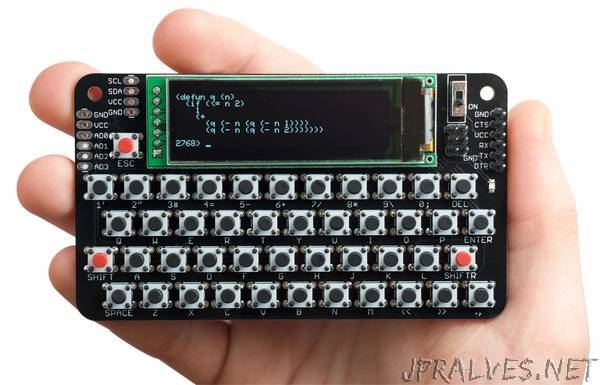
“This is a self-contained computer with its own display and keyboard, based on an ATmega1284, that you can program in the high-level language Lisp:
You can use it to run programs that interface to components such as LEDs and push-buttons via the I/O pins, read the analogue inputs, and operate external devices via the I2C and SPI interfaces. It has a greyscale OLED display that gives 8 lines of 42 characters, and an integrated 45-key keyboard optimised for Lisp.
Introduction
My earlier Tiny Lisp Computer 2 PCB was a board running Lisp that was just 3.25” x 1.5”, but although it had an integrated display, it needed an external keyboard.
I was inspired to make this new version when I saw Voja Antonic’s Belgrade Badge, a self-contained BASIC computer with an integrated keyboard and display designed for the Hackaday Belgrade conference in July 2018 [1].
The keyboard is based on tactile pushbuttons that are available for under 6 pence/cents each. I decided to keep the board as compact as possible by providing only the keys needed to program in uLisp, which meant departing from a standard keyboard layout. One benefit of this is that the keys you use a lot when entering Lisp programs, the parentheses ‘(‘ and ‘)’, are on two dedicated keys on the bottom row of the keyboard.
For the display I chose a very nice greyscale OLED display with a resolution of 256 x 64 available on AliExpress [2], which gives a text display of 42 x 8 characters. It’s slightly more expensive than the usual 128 x 64 displays, but is perfect for this project.
The Lisp badge is based on an ATmega1284P, which I think is the best ATmega processor for running uLisp as it provides 16 Kbytes of RAM, more than any other ATmega chip. This chip drives the display, scans the keyboard, and handles the Lisp interpreter, without needing any other active devices; the circuit uses every pin on the 44-pin chip.
I designed the Lisp Badge to be powered by an AAA-sized 3.7V LiPO battery, and the processor runs with a 16MHz crystal clock. According to the Atmel datasheet the ATmega1284 needs 3.825V to work at 16MHz, but I haven’t had any problems; if you prefer to err on the safe side you could use a 12MHz crystal, which should be fine down to 3.15V.”
